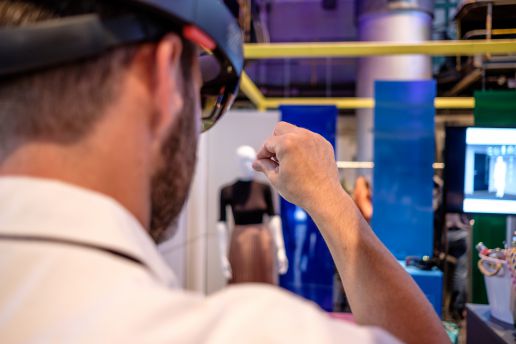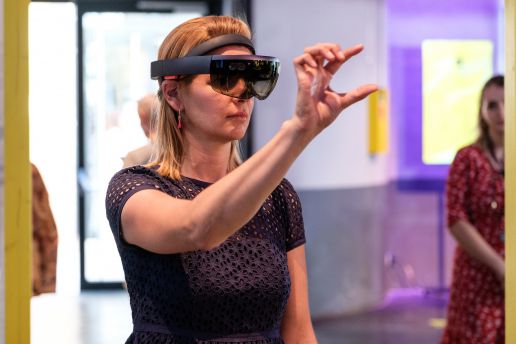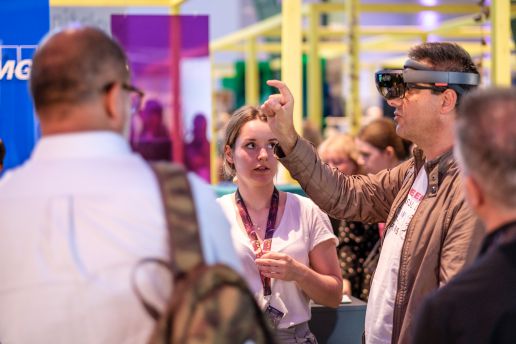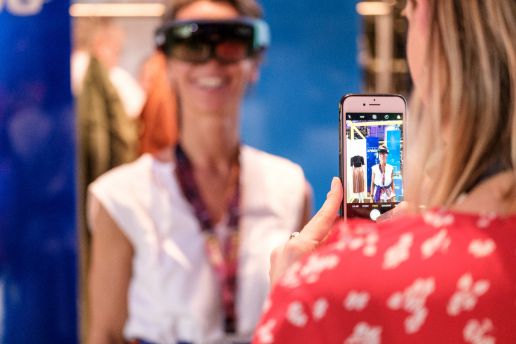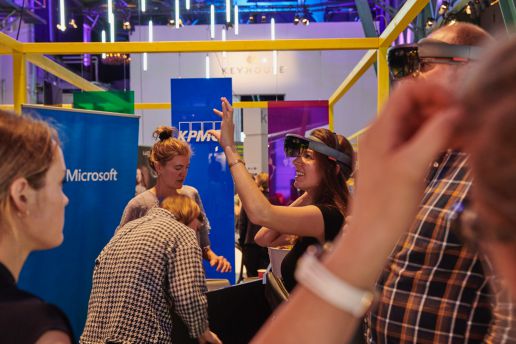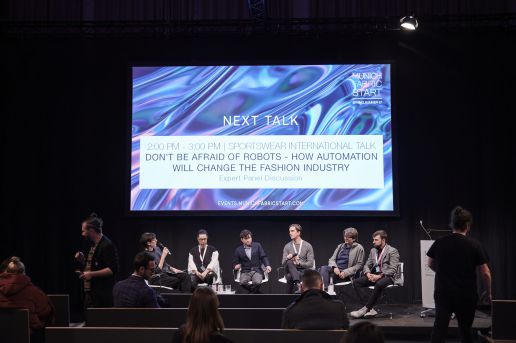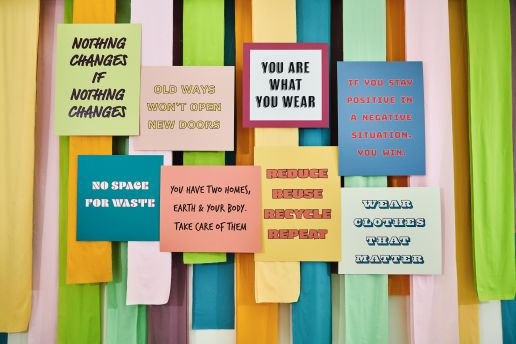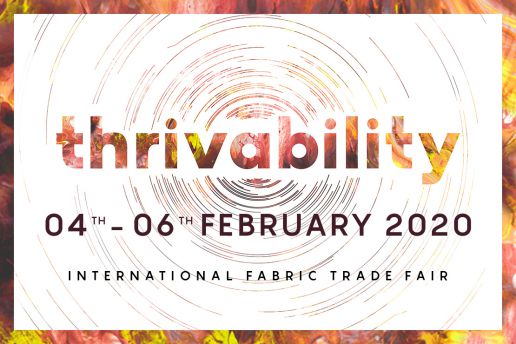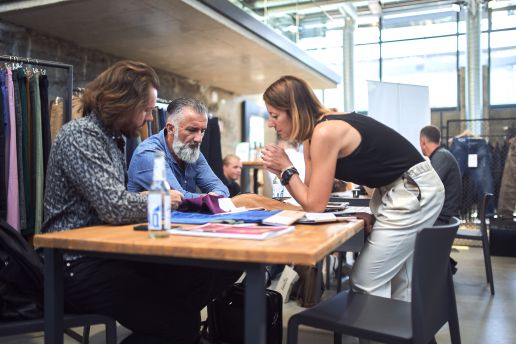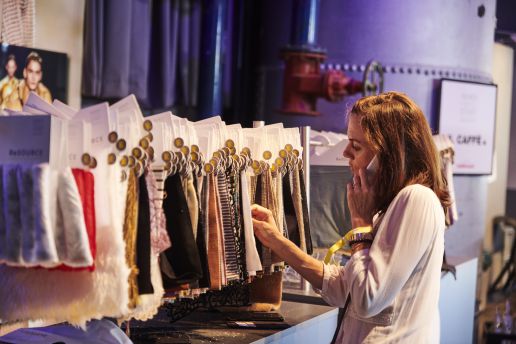Keyhouse
How Automation Will Change The Fashion Industry
SPORTSWEAR INTERNATIONAL TALK
DON’T BE AFRAID OF ROBOTS – HOW AUTOMATION WILL CHANGE THE FASHION INDUSTRY
In the February edition of Keyhouse at MUNICH FABRIC START, Sabine Kühnl, Editor-in-Chief at Sportswear International, hosted a panel about “Don’t be afraid of robots! How automation will change the fashion industry”. Five leading experts offered their unique insights into automation, digitalization and localization – which are currently some of the key trends driving the global fashion market.
With Ebru Ozaydin (Artistic Milliners), Jon Zornow (founder of Sewbo), Dr David Schmelzeisen (Research Associate of ITA, RWTH Aachen), Dr. Thomas Fischer (Head of Research at ITF Denkendorf) and Benjamin Baumann (Project Manager at Kuka).
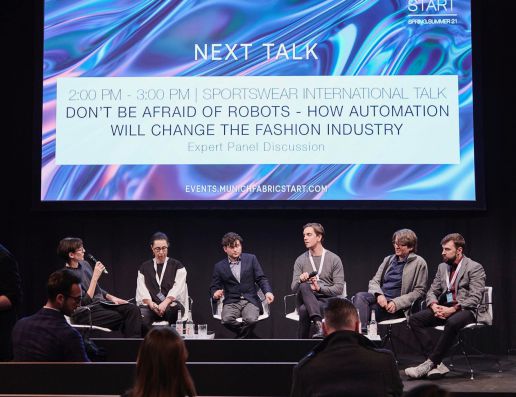
Don’t be afraid of robots! How automation will change the fashion industry
As we move closer towards a fashion system which resembles Industry 4.0, the five experts offered their insights into our current status and the role of automation, digitalization and localization.
Are we operating in times of Industry 4.0?
In terms of the classic, mass production of our fashion systems, our panellists agreed we are not fully digitized yet. Where Industry 4.0 is concerned, it has a lot to do with digitization and digital product development and simply the necessary steps have not been integrated throughout all areas of the production chain. Fischer estimates the progress among the various fragments of the fashion industry only reaches a maximum of 50%, with Baumann also suggesting that if we break down the many subtopics, we are making greater progress in some areas than others.
What then is the greatest challenge facing our industry?
Industry 4.0 relies on the exchange and sharing of data, which is currently still a problem for our fashion industry which is greatly fragmented. Where progress is often stunted due to manufacturers working conservatively instead of as part of a community which makes sharing and accessing data difficult. Collecting and processing data at all stages plays a vital role for Ozaydin, in order to bring more information about the production into the hands of the end consumer. With greater investment in automation technology, linking systems together in this way Zornow elaborates will make data sharing infinitely more efficient and available.
Is there a role textiles can play as part of Industry 4.0?
Textiles can be distinguished as part of the network where clothes can play an essential role in communication with its environment and the wearer. Through various integrated CPS’s (Cyber Physical Systems) such as sensors and antennas, textiles can become extremely useful materials for Industry 4.0 as well as a lot of other sectors. We explored this topic in greater detail with The Nurture Room project by fashion technology expert Pauline van Dongen also at the Keyhouse.
Will there always be a place for humans in fashion and textile manufacturing?
Through greater collaborative efforts and research into digitization, it will be possible to drive down the initial costs of automation which would lead to increased investments into automating processes. However, these will be non-value adding tasks and currently cannot replace the labour-intensive processes carried out by human beings. Schmelzeisen typically advises that 40% of production should be digitised but views the future of robots in the fashion industry as a collaborative relationship, where robots are brought in to assist workers and provide relief in difficult or strenuous tasks. Repetitive or mundane processes can be out sourced while increasing focus on value adding tasks only achieved by humans. There will be more jobs which evolve are suited to the human nature, their creativity and craftsmanship also in the development and management of these processes.
What is the role of localization in this new fashion system?
With global trends indicating that labour costs are set to increase in the conventionally ‘cheaper’ countries, this could make the higher investment costs of automation technology more feasible. At the same time, from a sustainability point of view, there will be an increase in companies operating regionally where materials can be processed and recycled locally. With solutions such as nearshoring, micro factories and smaller production centres offering attractive alternatives in times of political and environmental uncertainty. Also offering a solution to the high demand for personalisation and bespoke design services at the point of manufacturing, leading to the invention of new, customised technology and automated processes scaled to these new production processes. “Everything that can be digitized will be and everything that can be digitized can be personalised.” – Dr Thomas Fischer
Want to know more? Watch the full discussion now available on our YouTube channel.
Focus On Thrivability at MUNICH FABRIC START Spring.Summer 21
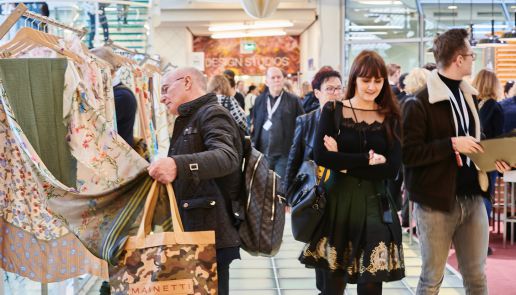
A PARADIGM SHIFT TOWARDS HOLISTIC SUSTAINABILITY
A new level of sustainability, digitalisation, transparency, a growing need for information and the desire to inspire - that's what the Spring.Summer 21 season stands for
The MUNICH FABRIC START with BLUEZONE, KEYHOUSE and the individual showcases presented by around 1,000 international suppliers of fabrics and additionals successfully introduced the Spring.Summer 21 season from 04 – 06 February in Munich. The approximately 18,400 international trade visitors were offered a broad spectrum of strongly positioned collections with innovative product and trend statements that demonstrated a new awareness of ecology and the increasing relevance of natural looks and resource-saving materials.
The MUNICH FABRIC START has shown very clearly that this fair format is convincing as a strong industry platform in times of changes and major challenges. Thanks to the professionalism and sovereignty of all those involved, the necessary responsibility to approach the reorientation of the market constructively and in a solution-oriented manner has been created. We have experienced this willingness in numerous discussions with exhibitors and visitors during the three intensively used days of the fair. We therefore feel confirmed in our current and future orientation.
Sebastian Klinder, Managing Director MUNICH FABRIC START

The design team of Boss Women emphasizes not only the good atmosphere but also the high-quality and quantitative offer:
We enjoy the relaxed atmosphere here in Munich. All the important suppliers are on-site, so we can work excellently. The main topic is of course sustainability and the correspondingly wide range of natural materials such as linen as one of the favourites for summer 21. There are also very innovative jerseys, bondings and neoprene knittings as new and exciting materials.
This was also confirmed by Theresa Austin, Advisor AKOJO MARKET, Co-founder Paris UIUX, LVMH Group Digital:
I thoroughly enjoyed my time at Munich Fabric Start. The Bluezone and Keyhouse, in particular, were eye-opening for me and I was very impressed at the number of suppliers working with innovative new technologies and methods to produce in more sustainable ways. It was a great showcase of sustainable innovation and it was very inspirational to speak with so many experts on such a key topic. I left both motivated and educated, with a lot to share back into my work.
Further background information on the main theme, the innovations of the season and the trade fair highlights can be found on our HOMEPAGE and in the PREVIEW PRESS RELEASE. High-resolution pictures can be found in the PRESS GALLERY.
FOCUS ON THRIVABILITY
The guiding theme THRIVABILITY met the current mood of the industry, in which future-oriented entrepreneurial spirit meets enthusiasm and a changing understanding of values.
In Munich, it became very clear that the era of sustainability is currently determining all talks and discussions in the textile industry. The tenor seems unanimous: The industry is on the right track and now it is time to take responsibility, turn information into action and create transparency.
Claudia Lanius, Lanius, highlighted the positive approach to a new form of open-mindedness:
The largest portfolio of sustainable products is on display here in Munich. Such a broad spectrum in this density cannot be found anywhere else. All major suppliers are on-site. In addition, there is an excellently staffed accompanying program of panels and discussion rounds. The acceptance of sustainable topics is increasing all the time, which is a very positive development overall. This is also reflected in the competent awards for articles in the ReSOURCE Area.

The increasing interest in sustainability, certifications and future-relevant topics confirms Franziska Dohrmann, GOTS:
Our contact to major brands is clearly increasing and the interest in certified articles is growing. Already on the first day of the fair, we recorded a strong visitor frequency with very good discussions. The increasing acceptance is also reflected in the highly attended lectures of the ReSOURCE Forum.
INFORMATION, RESPONSIBILITY AND TRANSPARENCY IN DISCUSSION
The different aspects, innovations, collaborations and communication concepts were also the focus of the numerous well-attended side events at KEYHOUSE, the ReSOURCE Area and BLUEZONE.
As a trade fair organiser, we also see ourselves in the role of an impulse generator that can generate a corresponding reach. Therefore, we attach particular importance to a qualitative and varied supporting programme which, thanks to international experts, offers an insight into current innovation topics, problems and solutions and thus forms the basis for transparent knowledge transfer.
Frank Junker, Creative Director MUNICH FABRIC START
Right at the start on Tuesday morning, trend forecaster David Shah addressed precisely these challenges in his enthusiastic Keynote „The 10 Design Pillars of Design“. The publisher and CEO of View Publications drew scenarios of new retreat possibilities and the search for structures and simplicity in times of digitalisation and diversification.
The panel discussion on the subject of “Future Textile Supply Chain” with international experts also provided new thought-provoking impulses on how the textile chain can be transformed through sustainable solutions and networking. In addition to transparency, intensive communication with consumers and the development of technologies, product development, quality and aesthetics should not be forgotten as indispensable criteria.

The textile value chain is currently being radically rethought. Every company has to deal with these impulses and develop individual concepts. One thing is certain: in the future, too, only those companies will be successful whose fashion fascinates and who act in an economically sensible manner. Digital processes, decentralized production, smaller batches, shorter lead times, comprehensive transparency and new circular business models – it remains exciting to see which of these developments are scalable and when. One thing is certain: now is the right time to develop principles for dealing with the new perspectives for your own company. In view of these fascinating prospects, a 90-minute expert panel on “Future Textile Supply Chain” is just enough to scratch the surface of the new possibilities.
Alexander Vogt, Kern. Consulting
INNOVATIONS, FUTURE MATERIALS & NEW TRENDS
Knowledge, transparency, quality, responsibility and communication influence the current multitude of product and process innovations.
Linen, both pure and blended with cotton, is the big favourite for the season Spring.Summer 21. Other material innovations were super-stretch silk, recycled polyester, Ecovero-Tencel linen, Naia and Cupro fibre blends or hemp textiles – the constant reference to natural fibres and surfaces was clearly visible.
The theme of Li Edelkoort’s exclusive trend seminar underlines this statement. In her two-hour “Green Wave” lecture, the internationally renowned trend expert presented her interpretations of Spring.Summer 21. Here, too, a rethinking of natural materials and looks was clearly evident. In her outlook on Autumn.Winter 21/22, she favours White as a global colour, on which new structures, styles and designs are based.

BLUEZONE – Reject egoism. Create ECOISM. Rewrite your future
The denim industry is facing new challenges, which the Blue Community faced as an optimistic and international community at BLUEZONE under the ECOISM theme.
The strong network of over 100 major international brands and numerous denim experts was looking for answers to a conscious consumer approach and a growing interest in ready-made solutions that offer future-oriented products, state-of-the-art technological processes and complex functionalities.

Current topics that determine the denim market were discussed in depth in lectures and international panel discussions. The Rivet 50 Talk on the topic of “2020 Vision” on the first morning of the fair gave an outlook on companies, technologies and fashion in the next decade. One of the key statements highlighted the changing demands of consumers – stationary retail can only survive with new concepts, such as offering sustainable fashion, vintage, and repair stores under one roof. This is precisely why the denim community must move closer together.

Alberto Candiani von Candiani confirms that the community spirit of the ECOISM guiding theme determines the future:
ECOISM – I love the concept, the slogan, the theme of this year’s BLUEZONE. It’s about green innovations, which must be visible and tangible, and about consumers who are better informed than ever before and are looking for a new way of consuming. We, as the Blue Community, are responsible for a massive change that will transform what is considered a “polluting” industry into a green model based on sustainable innovation and circularity. Denim can be seen as the most popular, “democratic” and perhaps “invasive” fabric ever made on the planet – and we, the Ecoists, want to change denim to become the representative flag for this revolution.
KEYHOUSE – A STRONG NETWORK OF CREATIVE MINDS
The think tank of MUNICH FABRIC START offered concrete approaches for a future-oriented textile and fashion industry. Information, transparency and interaction stand for an inspiring network of innovative projects and sustainable collaborations.

Munich Fabric Start’s advanced platform, KEYHOUSE, has been paving the way into the future for some time now, connecting innovators and the industry. The innovation space, which brings together game changers and pioneers, successfully gives traditionalists in the textile industry a glimpse of the future. KEYHOUSE provides the space for superstars of fashion technology to present new technologies, sustainable developments, expert workshops and trend seminars. I would easily describe KEYHOUSE as the “Department of Innovation” for fashion companies.
Muchaneta Kapfunde, Founding Editor-in-Chief FashNerd.com
In her keynote speech “Rethinking the business of fashion”, Muchaneta Kapfunde called for a rethinking within the fashion industry. The change is possible and necessary due to the influence of digitalisation and technology. Examples of fundamental changes are block chain transparency, compostable packaging, on-demand solutions and the production of textiles based on dairy products.

In the panel discussion of Sportswear International, international experts discussed how automation, digitalisation and localisation will change the global fashion market and what impact these new standards will have on CSR issues and sourcing structures.
Once again, the SUSTAINABLE INNOVATIONS Area at KEYHOUSE, curated by Simon Angel, received great attention. He emphasized above all the openness of the visitors to the complex topics, to new materials and material extraction. He said that particularly pleasing was the willingness to exchange ideas, form networks and thus strengthen the community of all those involved within the textile and fashion industry.
The Keyhouse has a unique energetic atmosphere with very inspiring visitors. Especially exciting was the great interest in holistic sustainable concepts that go into depth. So the industry is definitely on the right track
Chandra Prakash, Founder & CEO Cocccon
The future of the textile industry was not only discussed in the seminars and lectures – the MUNIQUE MOODS party on the first evening of the fair also provided an opportunity to strengthen the community and exchange information. Around 1,500 guests gathered in an elaborately staged and specially built palace tent.

MUNICH FABRIC START – A Paradigm Shift Towards Holistic Sustainability
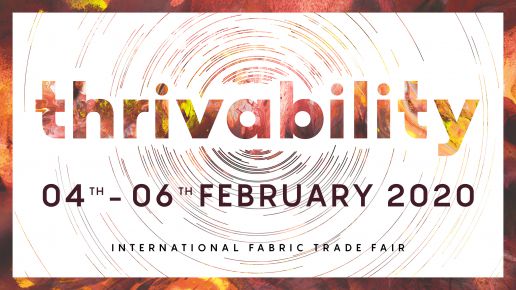
A new level of sustainability, digitalisation, transparency, a growing need for information and the desire to inspire
– that’s what the Spring.Summer 21 season stands for.
The awareness of a new ecology has become one of the strongest social movements. It challenges us to rethink, to take responsibility, to create transparency and to enter into an intensive dialogue.
The MUNICH FABRIC START with BLUEZONE, KEYHOUSE and the individual showcases presented by around 1,000 international suppliers of fabrics and additionals will introduce the Spring.Summer 21 season from 4 – 6 February in Munich. Approximately 20,000 trade visitors will have access to an extensive range of fabrics, additionals, designs, manufacturing services, supported by an informative and inspiring events programme.
The Spring.Summer 21 season is characterised by dynamism, waves and radiance – the guiding theme THRIVABILITY brings enthusiasm, creates excitement, let’s blossom and flourish. THRIVABILITY deconstructs our understanding of fashion and embeds a new, positive way of thinking: aesthetics and people see eye to eye; resources and nature are respected. This creates a new understanding of holistic sustainability and future-oriented entrepreneurial spirit. Spring.Summer 21 answers current market needs and reflects an evolved understanding of values. Knowledge, transparency, quality, responsibility and communication influence the current showcase of innovative product and processes on offer. THRIVABILITY combines the essence of this new era with a classic definition of trends and cultivates an inspiring and progressive direction for materials, fashion and design.


MUNICH FABRIC START HIGHLIGHTS
ASK THE EXPERT – Communication islands with THRIVABILITY experts.
Taking into account the focus on sustainability and innovation driven by THRIVABILITY, a new information concept will be integrated into the Trend Forum at the upcoming MUNICH FABRIC START. At various communication islands in the foyer of the MOC, industry experts will provide impulses and answers to current questions, from the origins of the material to exploring the diverse range of production processes and end garment recycling. Through direct discussions, you will gain valuable know-how, insights into topics and current solutions for both sustainable and innovative processes along the value chain:
CIRCULARITY | FIBERS & MATERIALS | MARKETING & COMMUNICATION | RECYCLING | SOCIAL RESPONSIBILITY
NEW ICON GUIDANCE SYSTEM
In addition, MUNICH FABRIC START has implemented a newly developed icon guidance system which in the spirit of transparency, identifies the sustainable and technical aspects of all the material highlights presented in the Trend Forums. In this way, visitors can establish these respective and previously hidden properties of textiles and ingredients at a single glance.
FABRICS
AWARENESS AS A DRIVER OF INNOVATION. Around 700 suppliers present their creative new developments across more than 1,000 collections – based on the latest technology innovations and the conscious and conservative use of resources. The fashionable combination of natural and innovative fibres is reflected in numerous new textile qualities including: luminous surfaces, wet gloss looks, soft glazes, colour gradients, transparent qualities, abstract patterns and relief elements. This season, MUNICH FABRIC START once again unites textile producers with a huge range of state-of-the-art fabrics, presenting not only essentials such as cotton, viscose, wool, elastane, lace and linen, but also novelties such as super-stretch silk, recycled polyester, Ecovero-Tencel linen, Naia and Cupro fibre blends or hemp textiles.
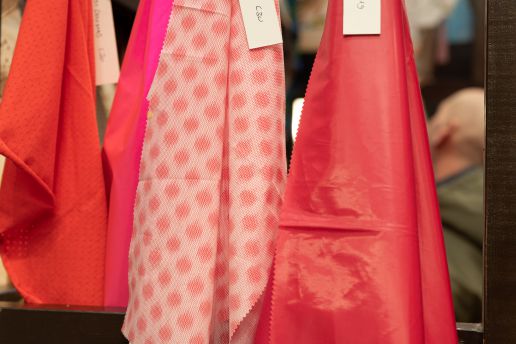
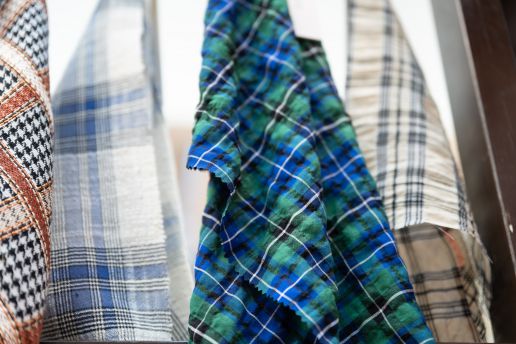
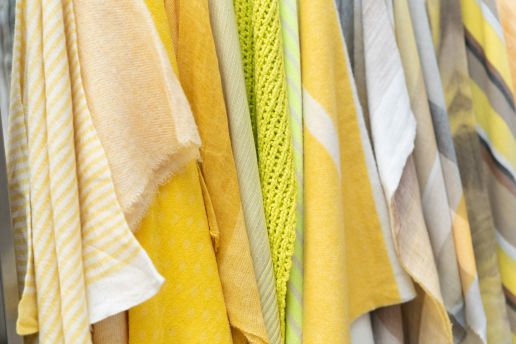
ADDITIONALS
TRIMS FOR FUTURE – this is the global motto which represents approximately 200 of the world’s leading international ADDITIONALS suppliers. Fashionable new developments revolve around iridescent surfaces, glowing yarns and electrifying colour applications. The focus is on recycled and sustainably produced products in natural colours. ITL Group will not only show its comprehensive range of products for the first time, but will also launch its C.A.R.E. Collection (Conscious, Affordable, Responsible, Eco-friendly labels) during the upcoming trade fair. Clic sums up these developments: “We have focused on realistic and organic articles that preserve nature both in form and texture”.
ReSOURCE
In a comprehensive forum, the ReSOURCE Area categorises and presents around 800 sustainably produced articles by exhibiting fabrics and additionals producers. “With our ground breaking DryIndigo® technology it is now possible to produce denim with 0% water consumption”, Tejidos Royo describes its latest milestone. Bornemann Etiketten sees the biggest challenge in balancing creativity, sustainability and efficiency, while Dutel focuses on timeless and durable top quality. Lanificio Roma pursues resource saving process solutions with the aim of wasting less and reusing production and consumption waste as new resources.
DESIGN STUDIOS
Natural colours based on sustainable dyeing techniques now determines the colour palettes of the inspiring designs at the internationally renowned, textile designers and trend offices in the DESIGN STUDIOS. The current change in the textile industry is leading to a revolution in the printing and dyeing industry and inspires a revival of natural dyes. Design Union and Primus Pattern also emphasize the simultaneous closeness to nature and diversity of textile prints for Spring.Summer 21.
SOURCING
Ready-made solutions are becoming more and more important and the interest in sourcing providers close to the market is also growing with a focus is on speed and a reduction in complexity. As globally established manufacturing companies in the SOURCING Area, numerous high-quality newcomers such as Easy Invest Solutions or Union 3 Fashion offer comprehensive insights into the entire textile production chain and its reliable procurement management. For Spring.Summer 21, Cascade Enterprises takes its inspiration from nature and returns to the basics in prints, fabrics and silhouettes. Sourcing specialist Fateks Kumas Tekstil offers and processes fabrics made from recycled PET bottles, also to conserve resources.
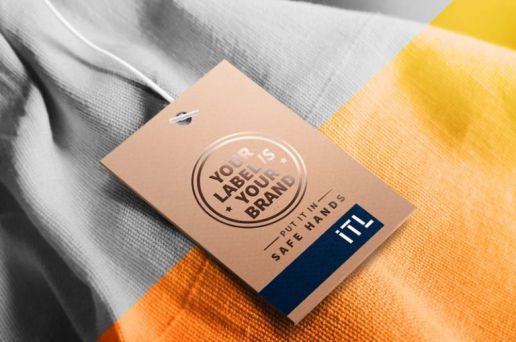
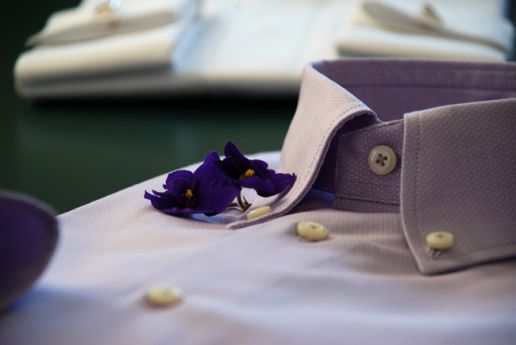
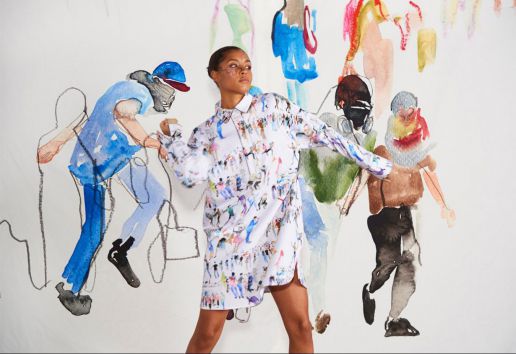
As the think tank for innovation, KEYHOUSE provides insights into future fabrics, new technologies, smart products & processes, sustainable innovations and alternative material resources, offering and inspiring pioneering concepts. For more information click here.
With over 100 major international brands, BLUEZONE has positioned itself as the initiator of an extraordinary, strong and innovative denim community. The answer to a conscious consumer approach and a growing interest in ready-made solutions that offer revolutionary products, state-of-the-art technological processes and complex functionalities. For more information click here.
KEYNOTES & SEMINARS
At the upcoming MUNICH FABRIC START, there will be a premium event programme featuring impressive panel discussions, polarising keynotes and trend seminars by international experts. The KEYHOUSE in Hall 5 will feature exciting lectures on the various subjects of innovation. The diverse events on offer in the BLUEZONE area of Hall 7 will provide an in-depth insight into the developments in the denim industry, while the ReSOURCE Forum in K3 in the MOC will offer an equally relevant programme on the topics of sustainability, certification and quality seals.
David Shah about „The 10 Design Pillars” – Tuesday, 4 Feb 2020, 10.30am – 12pm
The trend forecaster and publisher of Textile View will deliver the keynote “The 10 Design Pillars”. David Shah presents new perspectives on design influences from Slowbilisation to Hopepunk, from Biophilia to Datascapes.
Fashion Revolution – Tuesday, 4 Feb 2020, 12pm – 1pm
Ariane Piper gives an insight into Fashion Revolution – how the campaign will revolutionize the fashion industry. The viral campaign “Who made my clothes” will once again feature in the trend forums as an installation for transparency in the fashion industry.
Expert panel about „Future of the Textile Value Chain” – Tuesday, 4 Feb 2020, 2pm – 3.30pm
The panel discussion with expert participants on the subject of “Future of the Textile Value Chain” will be moderated by Jana Kern and Alex Vogt from KERN Consulting. The five international experts, including Prof. Dr. Michael Braungart, Hans H. Jung, David Shah, Jan Wilmking and Lauren Zahringer, will discuss the disruption and transformation through sustainability and networking in the textile value chain.
Rivet 50‘s 2020 Vision – Tuesday, 4 Feb 2020, 3pm – 4pm
What will the new decade bring for the denim industry and community? Rivet 50 will lead a discussion between some of the world’s most influential denim characters to discuss their predictions for business, technology and fashion.
Exclusive Trend Seminar by Li Edelkoort – Tuesday, 4 Feb 2020, 4pm – 6.30pm
Arguably the most famous trend forecaster of our time holds an exclusive trend seminar. In an impressive presentation, GREEN WAVE – the Fashion Trends for Spring.Summer 21, as GREEN BOOK – the Recreationwear Trends for Spring.Summer 21, as well as STILLNESS – a Full Colour Forecast for Autumn.Winter 21/22.
„Fashion Activism” Panel by Muchaneta Kapfunde – Wednesday, 5 Feb 2020, 11am – 12pm
FashNerd founder Muchaneta Kapfunde brings together the experts Kresse Wesling, Styliani Parascha, Marta Waydel and Marina Toeters as part of the panel discussion “Fashion Activism: Creating the Fashion of the Future.”
Hessnatur Stiftung about „The way to the green button“ – Wednesday, 05 Feb 2020, 11am – 12pm
Rolf Heimann, CEO of the Hessnatur Foundation, Institute for Applied Sustainability, explores in a lecture the question “How do I prepare my company for certification?”.
„How automation will change the fashion industry” – Wednesday, 5 Feb 2020, 2pm – 3pm
The five experts in technology, David Schmelzeisen, Ralf Schneider, Dr. Thomas Fischer, Jon Zornow and Sabine Kühnl will discuss “Don’t be afraid of robots – how automation will change the fashion industry” in a panel discussion. Automation, digitalisation and localisation are the trends that are reshaping the global fashion market. Is the fashion industry ready to adapt to new standards? What consequences does this have for the current procurement structure, also in terms of social responsibility?
“The data behind today’s winning marketing strategies” – Wednesday, 5 Feb 2020, 5pm – 6pm
Gina Gulberti, VP Digital Marketing at Launchmetrics, explains in her keynote “The data behind today’s winning marketing strategies”.
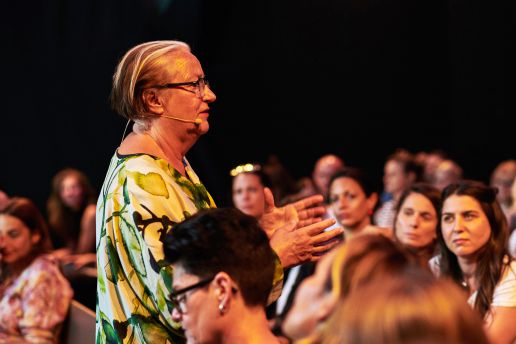
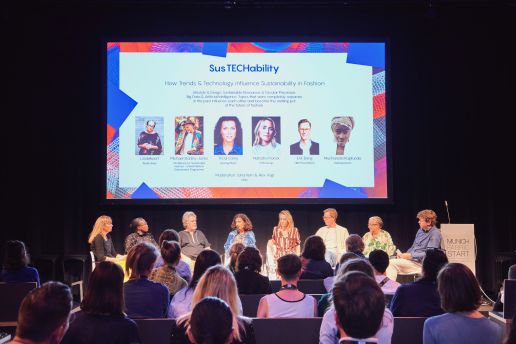
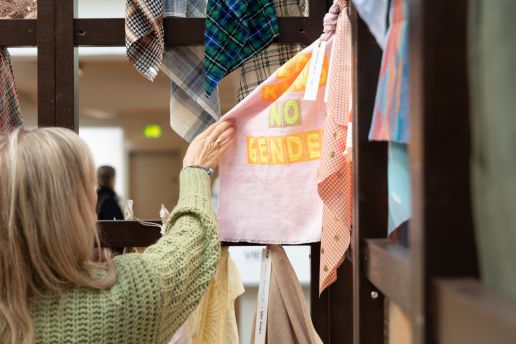
All dates and the complete events programme can be found here.
MUNICH FABRIC START & KEYHOUSE & SOURCING
04 February 2020 | 9.30am – 6.30pm
05 February 2020 | 9.30am – 6.30pm
06 February 2020 | 9.30am – 4.00pm
BLUEZONE
04 February 2020 | 9.30am – 6.30pm
05 February 2020 | 9.30am – 6.30pm
The Nurture Room: Interview with Pauline van Dongen
LET'S TAKE CARE OF FASHION TOGETHER.
During the previous edition of MUNICH FABRIC START, you presented the Smart Textile Pop-up Lab at the KEYHOUSE. What was it all about?
The aim of this Pop-up Lab was to familiarize people with smart textiles, and in particular those created by printed electronics. Through my work at Holst Centre (a leading Dutch R&D centre), I see the potential of printed electronics for the textile industry. These printed electronics are thin and stretchable and the printing process allows for a modular design approach. Moreover, they are made using familiar processes, namely through screen-printing conductive inks on flexible substrates like TPU and then heat bonding these smart “trims” onto textile. Visitors of the Pop-up Lab could see this process up close to better understand it and be inspired by the possibilities.
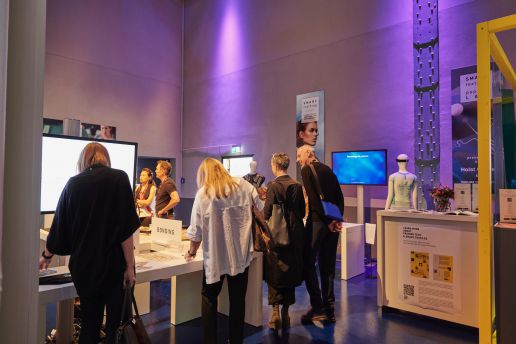
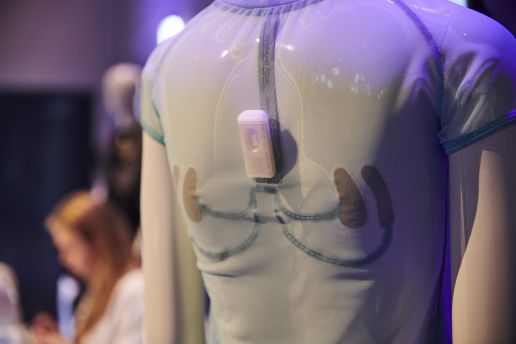
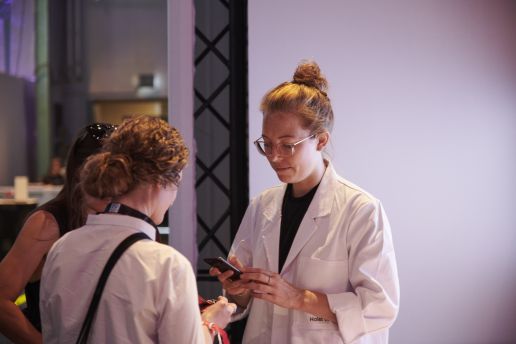
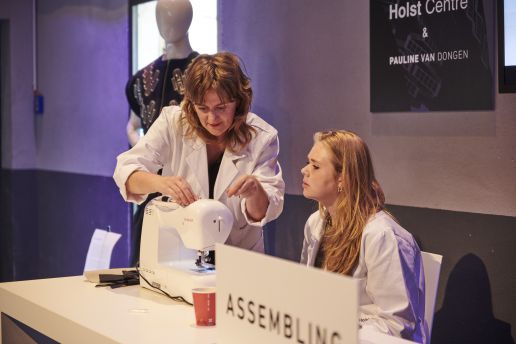
This time, visitors of the fair can book a (free) session in “The Nurture Room”. View the timetable and register here.
What will they experience there?
After having successfully shown the process of printing electronics and their integration in textiles, it is time for the next step. The Nurture Room is a space to reflect and to meet likeminded people who share a wish to do things differently within the fashion industry. It invites open dialogues addressing the urgency to create new relationships between humans and the clothing they wear.
The aim of the sessions at The Nurture Room is to not only inspire participants, but to ensure that they can follow up their inspiration with concrete actions once back in the office. You will be guided through the session by wearable technology experts: Pauline van Dongen and Marina Toeters. By booking a session on a particular topic, such as workwear, outdoor clothing or casual wear, you can tap into a wealth of knowledge and simultaneously help shape the direction of developments in the field of wearables.
The sessions are meant to connect companies covering the full value chain, in order to collectively contribute to new product developments. Together, we will discuss ways to embed technologies into clothing in ways that can nurture people and improve their wellbeing. Visitors will be able to encounter the latest developments that fall within this scope, such as MYSA 2.0: a “relax shirt” that guides the wearer through breathing exercises that can be felt through subtle vibrations along the spine.
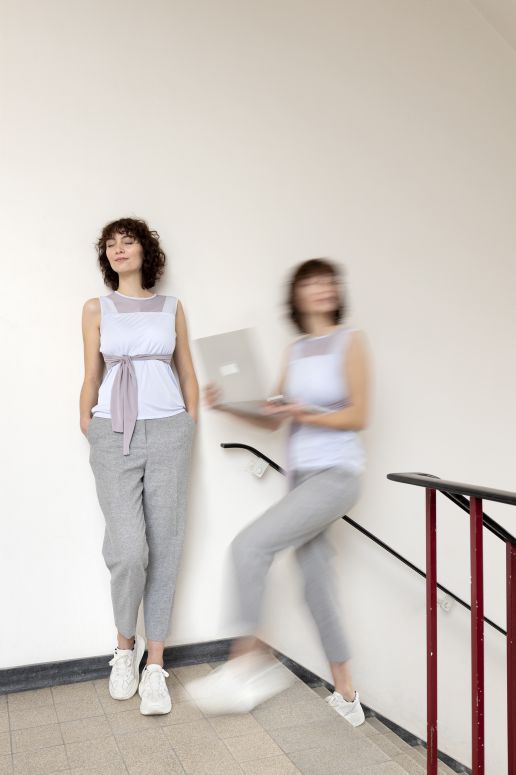
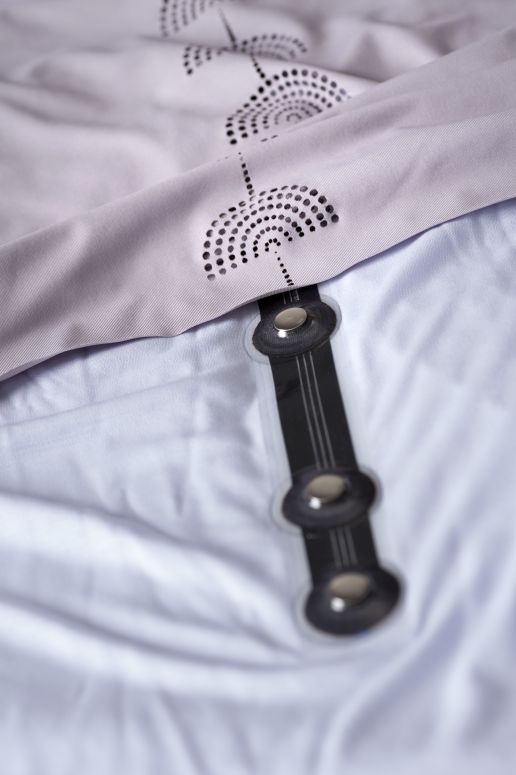
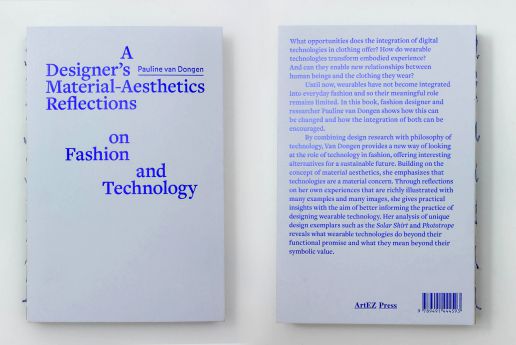
Can you tell us a bit more about your own research and how the idea of The Nurture Room relates to it?
In my own research, I focus on the way clothing mediates between our bodies and the world. Our clothes shape how we relate to the world, they actively shape our perceptions and our actions. I look at how we can strengthen our relationship and emotional bond with clothing and, by wearing clothing, with others and with the environment. When our clothes become active and responsive, how will this affect the human-garment relationship for example? My research shows that when we create wearables, we need to take into account the full set of experiential qualities of the garment, and not just the functionality of the technology. I extensively describe this approach in my recent book “A Designer’s Material-Aesthetics Reflections on Fashion and Technology”. It also includes practical guidance for designers and engineers who wish to develop wearables.
As a designer working between the fields of fashion design, textile innovation and technology, I understand these different worlds and know how to connect them. I would like people entering this space to think very consciously about what they want to develop and for whom, what new values the product will bring to people and how they incorporate considerations relating to the well-being of the planet. This ambition is reflected in the concept of The Nurture Room.
Why did you call it “The Nurture Room”?
Nurture is care that is given to someone while they are growing and developing. The term reflects the care with which we should all treat industry. In the context of “nature vs nurture”, the word “nurture” describes the influence of learning and other influences from one’s environment. I experienced how many new things I had to learn when I made a turn to wearables. In wanting to change the system as well as my own position and attitude as a designer, I also noticed that I needed to shed some of the premises that formed the basis for my fashion education. This learning and unlearning are processes that not many people in the industry take the time for or get the time for. While new perspectives are so desperately needed right now. So, to help facilitate this, our main message is: “Come and nurture yourself, by expanding your knowledge in the area of wearable technology.”
Visit The Nurture Room at MUNICH FABRIC START on February 4-6 2020 in Munich, Keyhouse, Booth #34
Due to the limited number of places available for the free individual workshops, we kindly ask you to register by mail to Chantal Gräff at cgr@munichfabricstart.com.
WORKSHOP TIMETABLE
Tuesday, 4th February
11.00 – 11.45 am: sports & activewear
14.00 – 14.45 pm: wool & tailoring
Wednesday, 5th February
11.00 – 11.45 am: workwear
14.00 – 14.45 pm: intimates
16.00 – 16.45 pm: outdoor
Thursday, 6th February
12.00 – 12.45 pm: casualwear
New Entries at MUNICH FABRIC START
Discover a selection of the latest suppliers and manufacturers to join the presentation of Fabrics, Additionals, Design Studios, Denim and Sourcing to showcase their collections for Spring.Summer 2021 in Munich. Register to attend now.

Forza Tekstil takes the expectations of their business partners to the next level by offering flexibility in production and perfect quality. The Turkish company is specialized in printed and plain fabrics, like viscose, viscose mixtures, cotton, linen, polyester and Tencel fabrics while adhering to the principles of productivity, sustainability and environmentally friendly production.
Section 2 | Stand F 208
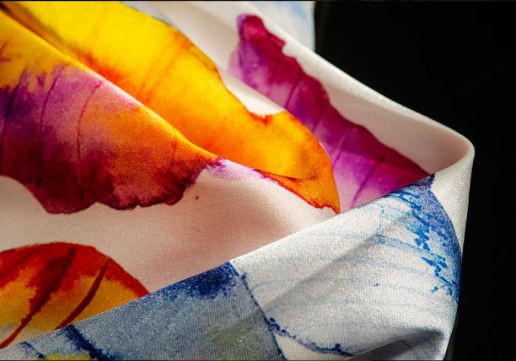
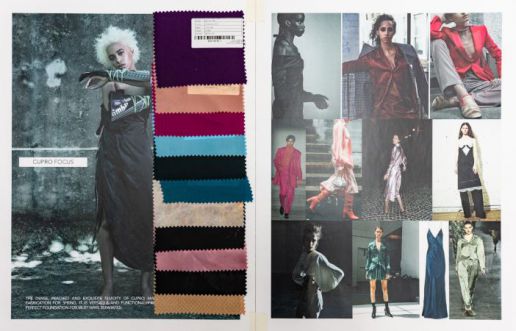
Shanghai Saite Silk was founded in 2004 as an incorporated company within the formation of the state-owned Shandong ZiBo No.2 silk weaving factory. We commit ourselves to designing, producing and selling women’s fabrics in the fields of silk, viscose and polyester.
Artrium 3 | Stand C 112
Telater creates with its long-lasting experiences and knowledge of raw materials and production techniques exclusive collections of fabrics and fashion with high quality. We are continuously evolving, visiting national and international fairs and catwalks in order to offer fabrics and designs aligned with the latest tendencies in the industry.
Hall 3 | Stand B 04
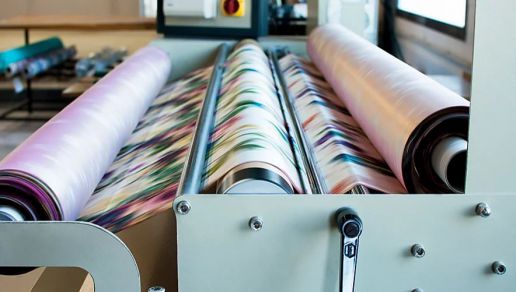
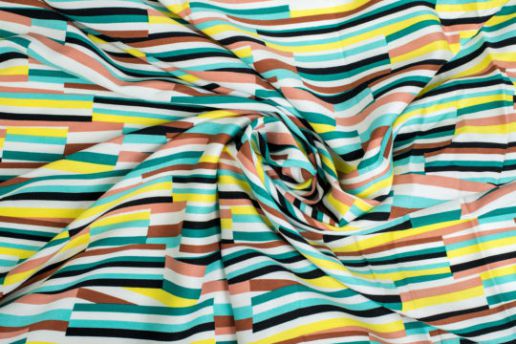
T-Style unites more than 1500 employees who work successfully every day on the development, production and improvement of high-quality knitwear made of cotton, viscose, polyester yarns and their blends. The company produces more than 20 tons of fabric per day – such as single jersey, pile fabrics, plush, interlock, ribbed textiles or fleece.
Section 2 | Stand E 224
Universal Textile produces underwear, outerwear, home textiles and upholstery fabrics since 1998. With a fabric production capacity of up to 60 tons per day, we offer outstanding services to brands from all over the world. We produce our fabrics in our own facilities in accordance with internationally recognized quality standards.
Section 2 | Stand E 221


Having entered the zipper sector in 1988, ECE Zipper has been running at its modern plant with 20.000 m2 closed site and its qualified staff in Avcilar Firuzköy, Turkey. ECE Zipper is an integrated establishment with its narrow weaving unit, modern dye-house, casting-house where special pullers are designed and produced with advanced technology machinery.
Hall 1 | Stand E19
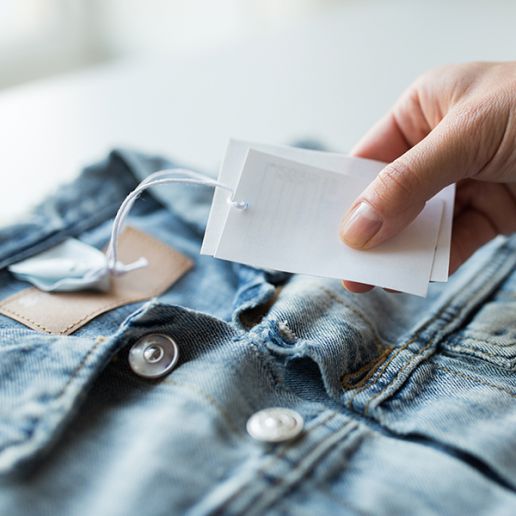
With over 12 years of experience in the trims and packaging industry supplying high quality products to a vast variety of domestic and international brands, we as Elements Printing and Packaging strive to give the best service to our customers. By remaining responsive to our customers’ needs and expectations, we are able to continuously adapt our business.
Hall 1 | Stand B15
Harmanci Label, as one of the leading label manufacturers in Turkey, serves to the biggest worldwide brands since 1931. Harmanci follows the needs of the sector as well as the fashion trends by producing woven, printed, screen printed and heat transfer labels and narrow woven ribbon in modern and environmental-responsible premises.
Hall 1 | Stand A 20
ITL is a global provider of Apparel Label Solutions supporting brands, retailers and manufacturers globally with a comprehensive range of products and services aimed at optimising brand identity and supply chain performance. Launching at Munich Fabric Start is their C.A.R.E Collection: a range of Conscious, Affordable, Responsible and Eco- Friendly labels that never compromise on quality or aesthetics.
Hall 2 | Stand A 19
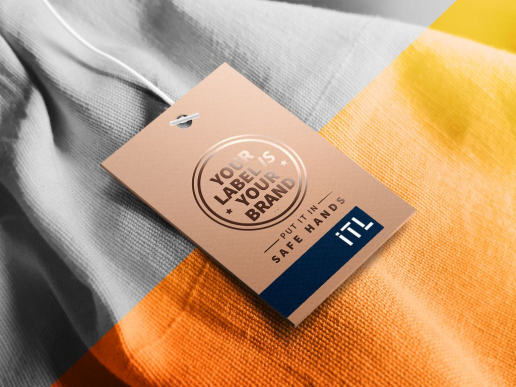
Linx Europe
Linx EU Newly developed collection made of recycled materials: outer fabrics, linings, trimmings. The focus is on sustainability and function alike. Mechanical functionality paired with innovative sustainable finishing variants. The fusion of fashion and function without limitation of hand feel and colour!
Hall 2 | Stand A 12
Sun Etiket is one of Turkey’s leading label and package design and -production companies providing services to national and international brands. Sun Etiket specialises in creating highly advanced, experiential labels and packaging since 1986. With over 150 experts in our team, we constantly focus on every brand’s uniqueness and strive to make the brand experience even more inspiring.
Hall 1 | Stand C 12

For over a decade, Denim Masters have worked in partnership with a variety of fashion brands as their denim apparel manufacturer of choice. Utilizing long-lasting tailoring expertise and traditional construction methods, our tailors and seamstresses create handmade garments of top quality at highly competitive prices.
Hall 7 | Stand B 06
Borkro Textile Wash LTD with its long-time experience in the textile industry, organizes and manages textile production in Bulgaria offering a complete range of women’s and men’s denim products, starting from pattern development to prototypes and from collections to bulk production. Furthermore, they are able to offer an extended variety of wash procedures and techniques which establishes them as one of the leading manufacturing companies specialized in denim garments. Their major goal is to offer fast and effective service, competitive prices, high standards, constant quality and high flexibility.
Hall 7 | Stand c 07
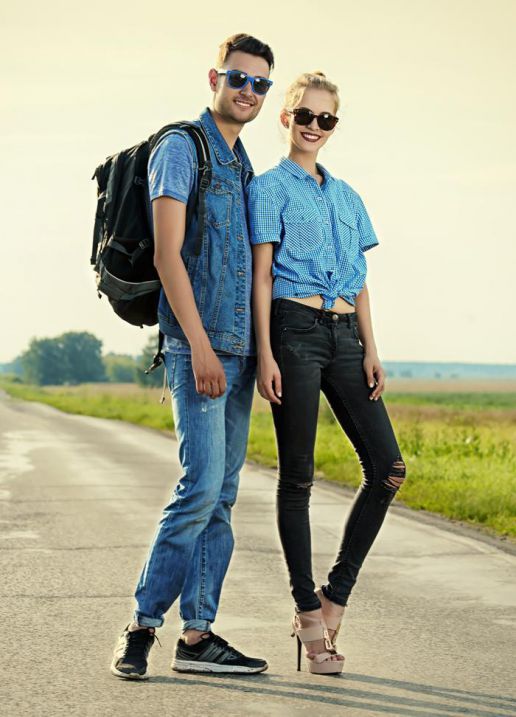
With a patented machine design and dyeing process, Island Denim can dye all the cellulosic fibres and blends in the desired yarn count (1 Ne – 200 Ne). By doing so, Island Denim gives stamina to many manufacturers of woven and knitted fabrics a great deal of freedom in the use of indigo in the design of their products.
Hall 7 | Stand c 20
Jeanci Konfeksiyon Tekstil produces mostly washed textiles on behalf of its own brand. The products are mostly denim, canvas, gabardine, satin and poplin. Besides, the company executes the finishing of woven fabric and textile by washing, dyeing in piece and other added values for final products. Jeanci has been manufacturing on behalf of prestigious brands in Europe for the last 23 years.
Hall 7 | Stand A 18
Stylers Group creates advantages for denim brands through strengths in sourcing, speed, stitching expertise and service, when it’s time for your jeans to take a step ahead – in fashion, sustainability and profitability.
Hall 7 | Stand B 03

Design Union is a textile print design studio producing unique contemporary fabric designs for fashion and interiors. The constantly evolving portfolio of silk screen and digital prints includes embroideries using vintage fabrics. The digital textile designs are sold to you as Photoshop PSD files in layers.
Section 1 Design Studios | Stand E 102
Primus Pattern is a textile design studio founded by Claudia Böhm. The qualified illustrator and owner of a studio in the heart of Munich is a creative researcher and conceptual partner in finding an excellent fitting and timeless design. Claudia Böhm combines drawn botany and geometry with handmade stylistics.
Section 1 Design Studios | Stand E 105


Care Applications works to reduce the environmental impact generated by the garment industry through new methods and devices. These developments are designed to optimize and modernize existing garment washing and dyeing machinery thus bringing improvements, savings and versatility. Within the Dye & Safe project, thanks to our advanced micro-nebulization metering device called ECOFinish together with our technical experience, we have been able to produce a traditional garment dye with exceptional penetration and evenness while using a minimum amount of water and greatly reducing the environmental impact. Care Applications offers this garment dyed with an even and penetrated standard dyeing process through the ECOFinish nebulization system saving 60% of water, 80% of energy and 99% of salt.
Hall 5 | Booth 23
A circular fashion industry is a regenerative system in which garments are able to circulate with maximum value retained for as long as possible before being able to re-enter the system through reuse or recycling. Therefore, we provide state of the art research, expertise and practical assets through workshops and software tools that help your brand transition towards circular practices.
Hall 5 | Booth 38
CLO Virtual Fashion creates cutting-edge 3D garment visualization technologies that cultivate a more creative and sustainable landscape for the fashion industry. CLO’s robust simulation engine allows you to create styles with countless layers and intricate details, which consistently solve glaring obstacles in your product life cycle.
Hall 5 | Booth 32
Recover works on the development of a closed-loop industry by offering brand, retail and factory partners a closed-loop solution for end-of-life waste management. The open-end spinner working for 7 decades with recycled cotton fibres is using textile waste as raw material to create new premium upcycled yarns. The Spanish company combines two resource and energy efficient processes – fibre upcycling and colour blend – to create new dye free upcycled fibres with accurate colours without using water or chemicals.
Hall 5 | Booth 15
A circular fashion industry is a regenerative system in which garments are able to circulate with maximum value retained for as long as possible before being able to re-enter the system through reuse or recycling. Therefore, we provide state of the art research, expertise and practical assets through workshops and software tools that help your brand transition towards circular practices.
Hall 5 | Booth 33

Cascade Enterprises is a cost effective, fully integrated, design-to-manufacture solutions service provider. The company offers ready-to-wear apparel to renowned retail and e-commerce fashion brands globally. We sample, source, plan, monitor and facilitate timely deliveries of high-quality goods that are ethically sourced.
Atrium 3 Sourcing | Stand D 110
Dragon Group Limited is an export-oriented company founded in 2001 and specialized in the development, manufacturing and distribution of fashion accessories. The company owns two factories for gloves production and at the same time has created partnerships with over 30 manufacturers of fashion accessories specialized in hats and scarves production.
Atrium 3 Sourcing | Stand D 108
Raith Textiles is a factory with GOTS and Oeko Tex certificate, producing baby- and children wear as well as women night wear for private labels.
Atrium 3 Sourcing | Stand D 104
Easy Invest Solutions is a manufacturer and exporter of high-quality men’s and women’s blouses with 20 years of experience. We supply both CMT as well as full product services, having among our suppliers the best of Italian, European and worldwide fabric producers. The company uses modern machinery and an automatic cutting system from Lectra. Prototype and sampling services are available as well as pattern creation and alteration and washing facilities for garment treatments.
Atrium 3 Sourcing | Stand D 110

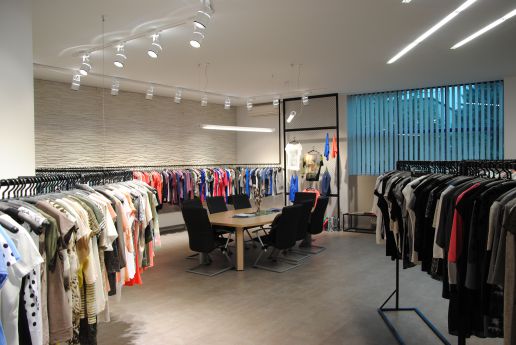
For 30 years now, Union 3 Fashion is a leader in women’s fashion, designing and manufacturing ready-to-wear garments. We are one of the largest export production units in the Balkans and Eastern Europe, exporting our products to many well-known clothing companies across Europe. Excellent customer service, competitive prices, best quality standards, quick production lead time, reliability and punctuality are among our main objectives.
Atrium 3 Sourcing | Stand D 105
A Discussion About SusTECHability
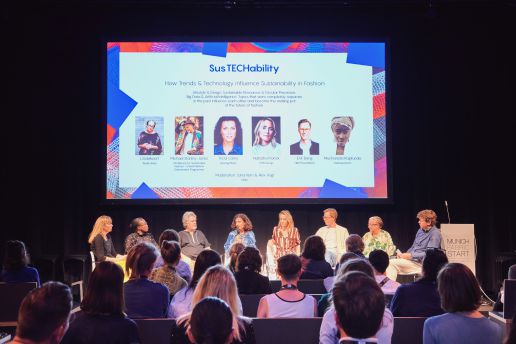
More than ever, the future of the textile and fashion industry is determined by new and highly complex topics. Sustainability has become the main driver in the fashion industry revolution, combining the awareness of greater consciousness with an increasing and urgent responsibility of all involved.
“Sustainability isn’t a trend; it’s a fact. As tradeshow organizers, we feel obliged to provide an internationally established platform for targeted solutions, sustainable innovations and discussions surrounding these issues. We see ourselves as a platform and a voice of the industry. And in this role, we offer a significant advantage in terms of awareness and reach.”
Sebastian Klinder, Managing Director, MUNICH FABRIC START
Alongside sustainability, digitization and technology are the complementary catalysts that increasingly redefine product and process solutions and, in doing so, provide significant momentum for the progression of one of the world’s largest industrial sectors.
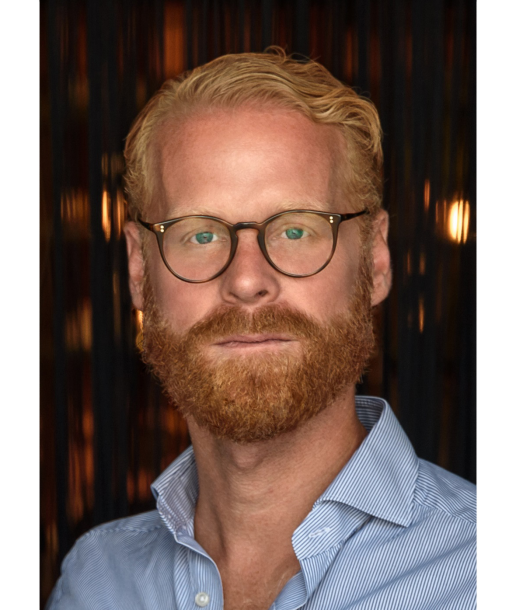
Digitization, such as what’s found through blockchain technology, makes it possible to guarantee the level of transparency demanded by the consumer. In addition, there is the prospect of a new visual aesthetic—and thus optic innovations—that can only be created through the use of digital technologies.
“Fashion has to pursue a hybrid approach overall so that the apparel industry can really opt for sustainable innovation, allowing it to implement sustainability initiatives with a high degree of design, disruption and integration of new technologies,” Muchaneta Kapfunde, founding editor-in-chief of FashNerd.com, said.
Such practices can already be found today. Rosanne van der Meer, founder of The Girl and the Machine, which designs and produces personalized knitwear based on 3-D knitting techniques, demonstrates this with the NIO New Industrial Order personalized fashion laboratory. “At first, I thought it was a problem that sweaters developed with 3D technology looked different than conventional, traditional knitted styles,” she explained. Only in the course of the process did she realize that this could be a real and unique selling proposition, and that perhaps 3D knitting would establish its own recognizable look that could stand out from conventional styles.


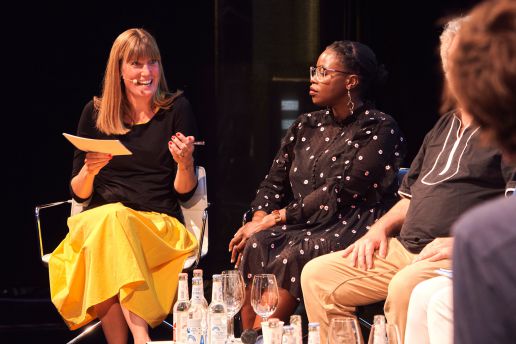
The textile and fashion industry is facing a fundamental upheaval. In order for the garment industry to rely on sustainable innovation, it is necessary to adopt a hybrid approach that enables sustainability initiatives to be implemented with a high degree of design and integration of new technologies. The demand for sustainable products and correspondingly transparent, resource-efficient production is one of the most urgent challenges faced by all suppliers and producers of relevant fabrics and accessories.
This assessment is mirrored by Alex Vogt of Kern Consulting, an analyst for innovation and corporate responsibility. Vogt views technological developments as the key to dissolving the current contradiction between a growing textile industry and the need to conserve resources. “Ranging from transparency, recyclability to surplus production, the potential applications for big data, artificial and amplified intelligence are wide and varied,” he said.
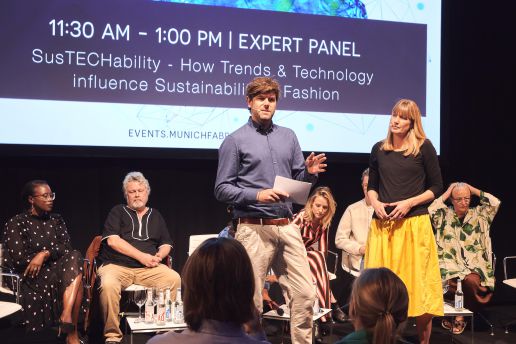
“Certainly this panel was significant in its disciplinary range and approach. Thus, a discourse emerged between the public-sociological perspective, with Li Edelkoort, the UN and the media on the one hand, and the H&M Foundation, Lenzing and EON on the other as those who are bringing real innovation to the industry.”
Alex Vogt, KERN Consulting
Munich Fabric Start currently presents these fields through concrete showcases, substantiated information and numerous new products for a broad market, thus promoting this necessary dialogue. As one of the most important international fabric trade fairs, with more than 1,000 suppliers of fabrics and additional items—showcasing well over 2,000 collections per season—Munich Fabric Start has been engaged with issues surrounding innovation from a very early stage.
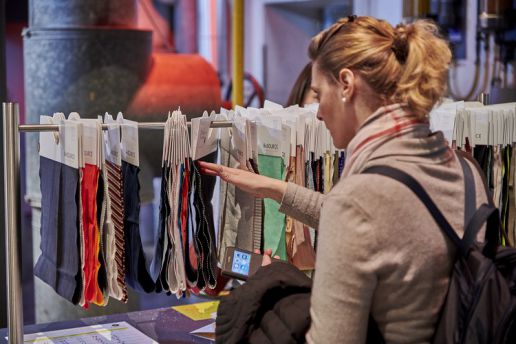
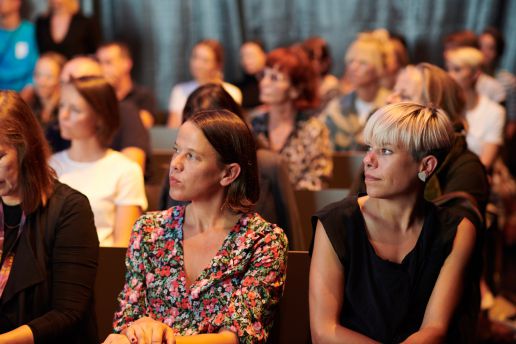
Through a series of dedicated areas for each segment, supported by proven experts and associations, the trade fair offers a comprehensive range of beautiful, certified fabrics and accessories. As a think tank for new technologies, sustainable innovations and smart textiles, the Keyhouse area of the show bundles new approaches in these areas through interactive presentations. Acting as a communication forum for dialogues, interviews, statements, seminars, panels and round tables, it serves as the ideal platform for synergies and cooperation.
“At Munich Fabric Start, particularly in the Keyhouse, there is a very special atmosphere. Here the most varied forms of creativity collide. Moreover, we use this opportunity to explain our products, strategies and co-operations in seminars and to launch projects,”
Tricia Carey, Director Global Business Development, LENZING FIBERS

As the representative of a strong community, now more than ever viewed as responsible for initiating processes, it makes expertise accessible, ultimately providing the tools and solutions for these future-oriented processes.
Content, communication and connection are the elementary parameters of a textile and fashion industry that is currently reorganizing itself. A change of thinking is occurring, and Frank Junker, creative director Munich Fabric Start, pointed out the great commitment held by the fair to make a significant contribution to the redefining the future of textiles.
“With the help and support of experts, renowned enterprises and ambitious startups—combined with courageous creative minds and committed young designers who are shaping their own future in new ways—we are setting new standards in a very focused and solutions-oriented way.”
Frank Junker, Creative Director, MUNICH FABRIC START
As future vertical brand co-operations become increasingly important, the goal must be to integrate performance characteristics and sustainable solutions within clothing in such a way that it becomes a real selling and buying argument that resonates with respective fashion brands. Against the backdrop of a multifaceted and hugely diversified industry, Munich Fabric Start is positioned as a platform for intensive business and successful networking.

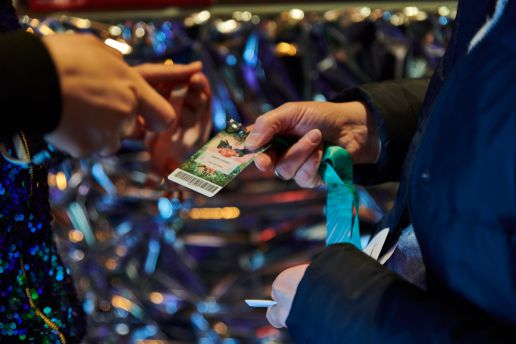

The next Munich Fabric Start will take place Feb. 4-6, 2020, and will showcase the main topic THRIVABILITY.
Discover the list of exhibitors here.
A Conversation On Sustainability, Transparency & Mainstream
From slow fashion to mainstream business, materials to education, fashion and sustainability raise so many questions. A vast and complex issue, Muchaenta Kapfunde of FashNerd turned to 3 women making a difference in the sustainable fashion space.
Charney Magri a fashion photographer turned documentary maker. The co-founder of Fashion 4 Change has worked for the likes of British Vogue and Ralph Lauren, and now she is a partner for do epic sh*t. Olivia Pinnock is a London-based fashion journalist, lecturer and founder of The Fashion Debates. She is dedicated to uncovering insightful stories in a fascinating industry and promoting positive change for a more sustainable future for it. Abigail Morris is the Founder and CEO of Compare Ethics. It is a start-up that connects you to ethical brands through the latest online and offline experiences. Since launching in 2018, Compare Ethics is regularly featured in top social feeds and connects thousands of ethical shoppers with brands each week.
On the topic of sustainable fashion, I asked Charney, Olivia and Abigail to share their perspective on the most commonly asked questions.
CHARNEY MAGRI
Do you think that eco-fashion is still a niche market? If so, why?
The day that ‘Eco Fashion’ is just called ‘Fashion’ and is accepted as the norm, will be the day that I believe ‘Eco Fashion’ is no longer niche but rather just common sense.
In your opinion, what are the top 3 things that brands should focus on with regards to promoting their sustainable practice?
I don’t believe there are three focuses on promoting a sustainable brand. However, there are two main verticals in sustainable fashion: environmental and human rights. Both need to be addressed and both need to be made transparent for the success of any [sustainable] brand. As a visual communicator, I want to see all brands talking about this to their consumers as well as the right certifications in place to verify their practices.
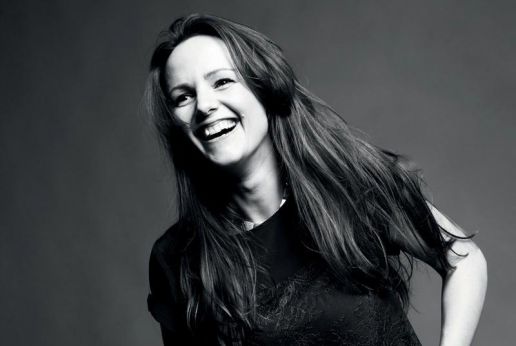
What advice would you give an individual looking to start-up a sustainable fashion retailer, particularly with the threat of a current ‘retail recession’?
Research is the first most crucial piece of advice. But the biggest obstacle you will come across is finances. Sourcing sustainable fibres and fabrics are more expensive than unsustainable options and mills will not accept small runs. You must build relationships with suppliers to be able to get the smaller quantities needed, and this takes time. I really believe there is a future in collaborating with like-minded designers to approach companies together so you can fulfil your orders when starting out.
ABIGAIL MORRIS
In your opinion, what are the top 3 things that brands should focus on with regards to promoting their sustainable practice.
1) Create a strong storytelling environment. Whether via online or offline experiences, sustainability is best shared as a story that people can easily back and tell their friends.
2) Be authentic. Nobody is perfect when it comes to sustainability. Bring people on your journey and celebrate your achievements with your community in real time.
3) Strive for increased transparency. Open up your supply chain and show people you are working to the highest ethical standards. Whether you are showing who made your clothes or using blockchain to track your supply chain, people increasingly want to know the provenance of your products.

Do you think ethical clothing will ever out-compete the mainstream less ethical products and dominate the fashion industry in the future? Why?
I don’t think new ethical clothing alone will out-compete the mainstream. However, what is more, interesting is how new business models will disrupt the fast fashion industry. ThredUp found that the second-hand market is growing 21 times faster than retail apparel over the last three years and is on track to be larger than fast fashion by 2028. At the same time, fashion rentals and sustainable fashion are moving into the mainstream. Given that fast fashion relies on volume, it will be interesting to see how and when mainstream brands will pivot towards a conscious fashion future.
Why do you think people are still buying from mainstream shops that sell unethical clothing?
People still buy unethical clothing because there is a variety with a strong product-market fit, and it is super easy to find. Sustainable fashion is making amazing strides on these areas. We increasingly see brands get product quality, price point and aesthetics right, but we need more choice and scale to compete. This has to be coupled with an easy way to find sustainable products. This is why we set up Compare Ethics – we know there are amazing sustainable products out there, it just has to be easy to find them.
OLIVIA PINNOCK
What do you see as the biggest challenge in getting customers to seek out more ethical and sustainable alternatives to high street fashion?
The biggest challenge is the convenience of mainstream fashion. It is far easier to seek out familiar brands that the consumers’ trusts, are fresh in their minds because of advertising and offers affordable fashion with next day delivery than it is to look for alternatives. Greenwashing is another issue that does damage to the whole sustainable fashion community as shoppers are not sure who they can trust.
What steps can we take to increase transparency and accountability for high street retailers?
I think governments have a tremendous amount of power in making the fashion brands that operate in their countries more transparent. We have seen it here in the UK with the Modern Slavery Act and the Environmental Audit Committee’s investigation into a fast fashion which bought CEOs from some of the biggest UK retailers into parliament to testify on what they’re doing about the issue. Companies are not going to give over information about their practices and their suppliers willingly for fear of giving valuable information to their competitors, but governments have the power to say that protecting garment workers and the environment is far more critical than that.
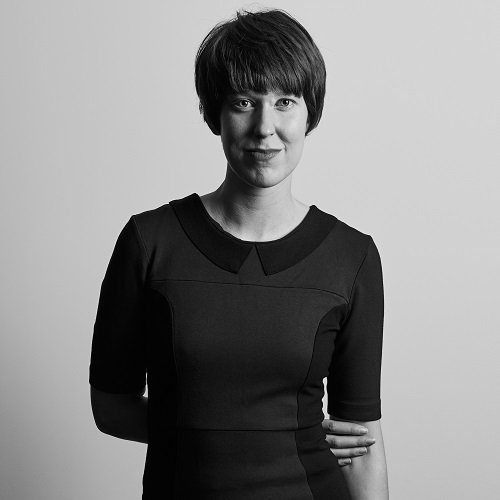
What advice would you have for people that want to be more conscious of their fashion choices?
Start with the wardrobe that you have. Consumers can make the most significant difference by changing how much they buy and how they manage their clothes at the end of their life. There are things you can do to support more ethical brands and put pressure on big brands, but where you can make an immediate, tangible impact is in your own home. Take steps to reduce how much clothing you’re buying, if it’s possible, and when you’re done with a piece of clothing, ask yourself whether it can be repaired or upcycled instead. If you still want to throw it away, can you give it to a friend to extend its life? It’s much better to give it to someone you know will wear it than take it to a charity shop where you don’t know where it will end up, especially if they can’t sell it if it’s not worth hanging on to someone, research how you can responsibly dispose of textiles in your local area through recycling schemes.
SUSTAINABLE INNOVATIONS: Interview with Simon Angel
You’re curating the Sustainable Innovations forum at Munich Fabric Start for the fourth time. Where are you looking for these new ideas and concepts?
I follow the heartbeat of current and future matters and perspectives. I am inspired by people and products which question the quality and essence of life. This leads me to the roots of the design processes, to the inner core of the industry, research institutes and universities. Textile innovations can be found in all different kinds of areas from fashion to health care, automotive as well as many other sectors. The art of thinking outside and inside the box at the same time plays a central role to find new innovations.

What do the showcased projects have in common?
There are two aspects which unite the Sustainable Innovations: poetry and purpose – and we most definitely need both! We need people who respond with poetry to inspire and open up new ideas and we need the hardcore problem solvers. With this edition we show several projects that provide concrete examples of what the successful interplay between poetry and problem solving can look like. Be it in 3D printing solutions or in human capital or in terms of circular solutions. Sustainable Innovations showcases great examples of what re-thinking and re-acting can lead to.
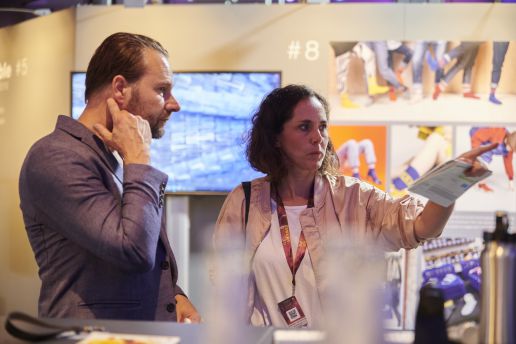
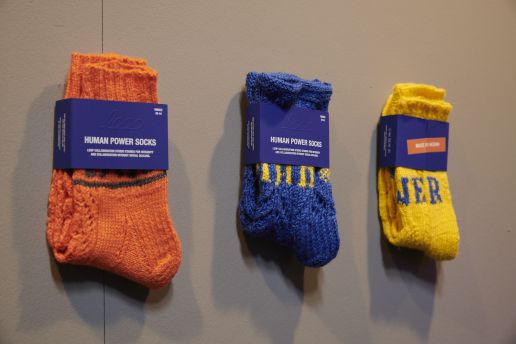
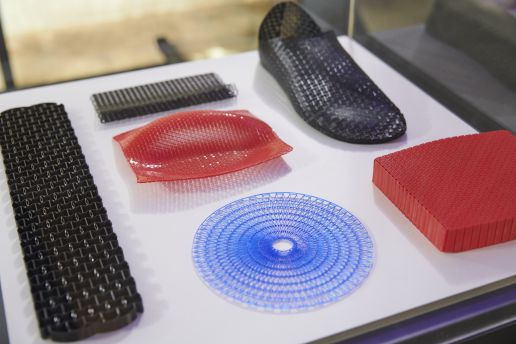
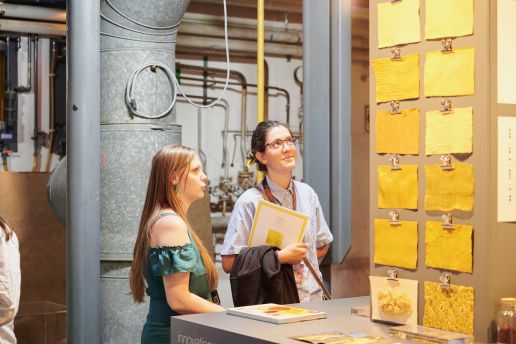
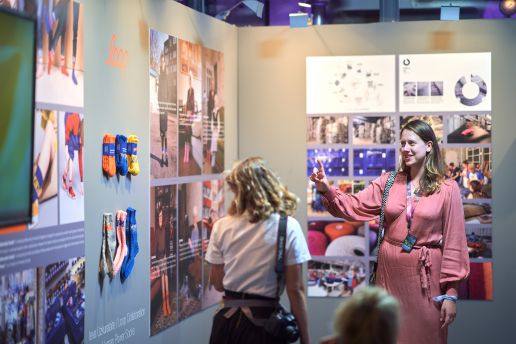
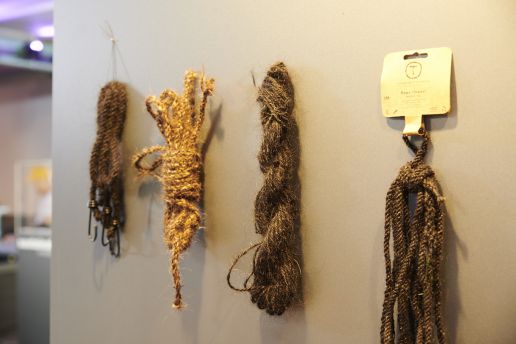
With regards to the exhibits, do you see any major trends?
I see the need for and can almost hear a desperate cry for contact. People want to develop a deeper relationship with each other but also with products and materials. The overload of information and the limitless possibilities to connect brings us to the essence of connection: purpose. The designers question their activities, relationships, products, services and business models in order to establish connections that make sense. Connections which will enable and explore new ideas, materials and directions. The power to create a new kind of connection is the next innovation: meaningful people, purposeful like poetry.

What can the industry learn from Sustainable Innovations?
Perhaps it’s not so much about learning something, but more about opening up and establishing a dialogue. The designer has their own view of the market as well as human needs and the industry has its own view and perspectives as well – but these two perspectives are not always sufficiently aligned. Therefore collaborations are key: BEyondAWARE!
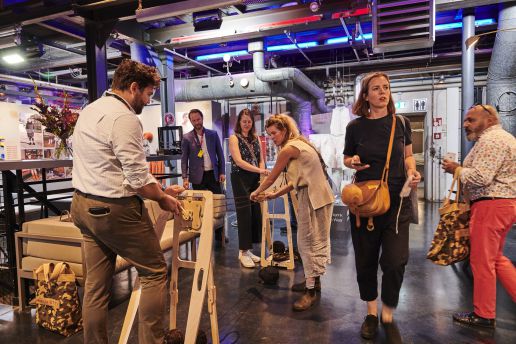
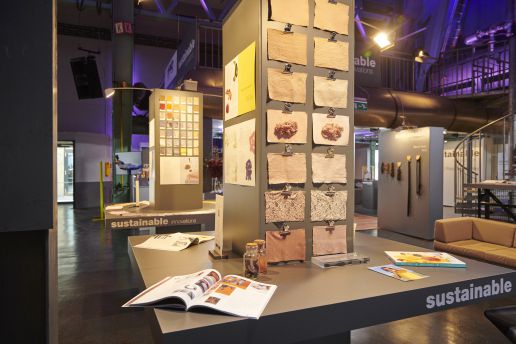
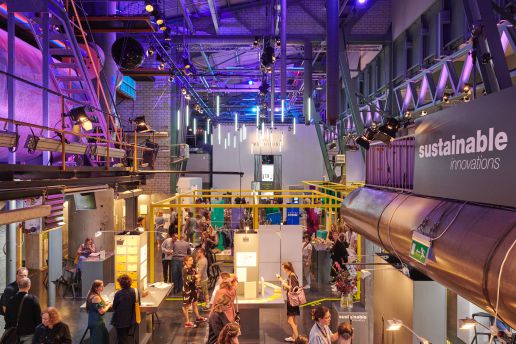
Digital Fabric Lab – The Future Begins Now

Digitization 4.0 is one of the most important topics of the future when it comes to process control within the textile and fashion industry. At the same time, the digitization of fabrics in the preliminary stage of the clothing industry still poses a major challenge.
One of the key building blocks within these technical undertakings will be the digitization of materials and additionals. Digital material parameters such as elasticity, flexibility, tension and rigidity must be determined for the realistic presentation of textiles in product simulation. For these physical measurements, surfaces, colours and textures must be captured and combined in a technologically feasible way.
What this process of analysis looks like in practice, as well as how fundamentally this new achievement changes and accelerates production processes, is demonstrated by a DIGITAL FABRIC LAB which will be featured for the first time in KEYHOUSE.
‘We are convinced that in the future there will be a digital twin for every fabric or button presented. Through an innovative analysis process, the speed of the production process can be increased many times over. ‘
Sebastian Klinder, Managing Director MUNICH FABRIC START
In a community showcase initiated by MUNICH FABRIC START, leading specialist companies and university professionals have joined forces to demonstrate the individual steps in this new type of process in a comprehensive and practice-oriented manner using simulated digitisation stations.
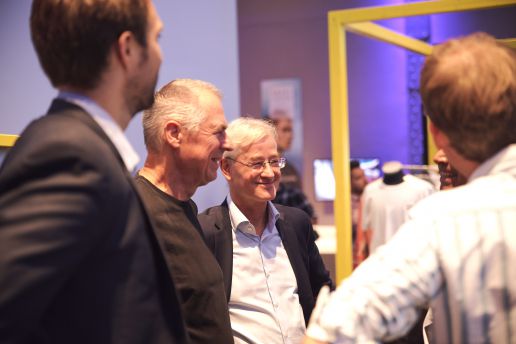
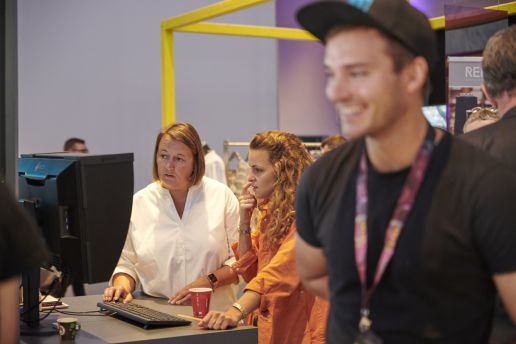
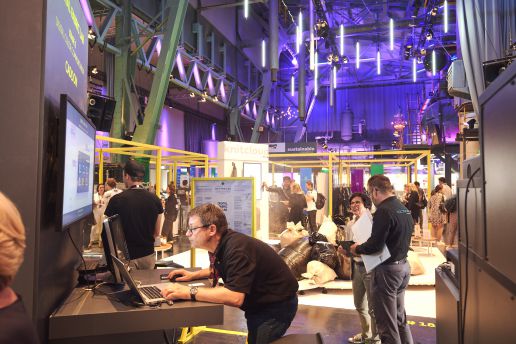
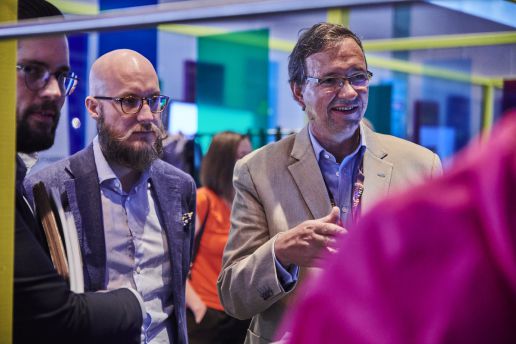
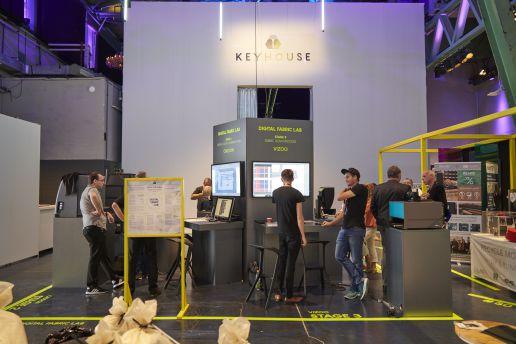
/ STAGE 1 /
# PHYSICAL FABRIC MEASUREMENT
The accurate and informative value of the virtual simulation will on the one hand depend on exact physical parameters for the true representation of the textile material. As well as the transformation into corresponding parameters assigned by the simulation material model and on the other hand it will also depend on exact model calculations.
To describe the material behaviour, the basis weight, the material thickness, the rigidity, the elasticity and the draping behaviour of the textile surfaces can be determined and processed accordingly. This makes it possible for the user to make design and fitting decisions on a purely virtual basis, both for products that will be close to the body as well as those positioned further away.

Technische Universität Dresden
Helmholtzstr. 10
01069 Dresden
Germany
/ STAGE 2 /
# DIGITAL COLOUR COMMUNICATION
Caddon’s multi-spectral technology provides the visually stimulative effects of the design’s colours as well as its spectral data measurements, pixel by pixel in a rapidly captured and communicated image data set, thus making a significant difference to single spectral colour measurement.
With Caddon’s colour digitization, accurate colour values are available where they are needed :
- – in the form of digital colour books with comprehensive colour codes for designers.
- – in the form of digital multi-spectral images for visualisations for production and marketing.
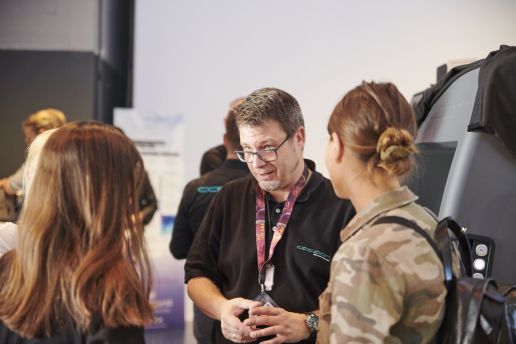

Caddon Printing & Imaging GmbH
Stadionstraße 6
70771 Leinfelden-Echterdingen
Germany
/ STAGE 3 /
# FABRIC SCAN PROCESS
The visual properties of a material sample, sized max. A4, are recorded with the xTex scanner within 1 to 2 minutes. The digitised material is then made into a Tileable, block pattern repeated seamlessly with the help of the xTex software, in a further 5 mintues. Tileable means that it is seamlessly repeated and can be applied to larger areas than initially captured using 3D application.
If necessary, in the following step we can use Caddon’s export colour data to colour or retouch the material using our xTex software for a more accurate colour representation. The finished digital material can then be used in Vidya, for example.
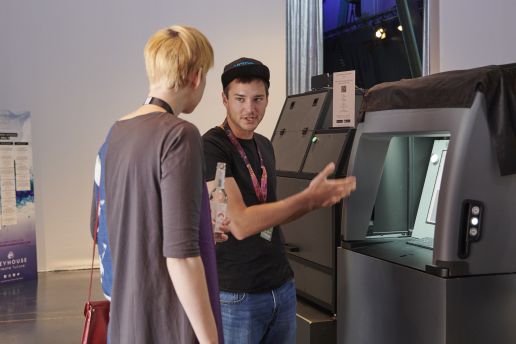

Vizoo GmbH
Johann-Karg-Strasse 30
85540 Haar
Germany
/ STAGE 4 /
# DIGITAL FABRIC SIMULATION & VISUALISATION
3D-Vidya offers the best simulation of cut and material. With 3D-Vidya a piece of clothing becomes digitally visible on the computer, creating realistic decision making bases for designers, product developers and all others involved in the creation process of a collection :
Cutting concepts are visualized.
- – A design becomes immediately visible and can be optimized.
- – Details immediately available including drapery, imprints, ornaments which can be optimally placed.
- – Texture and material properties including elasticity or material thickness, distance to body, gloss structures or wrinkle effects can be precisely represented
- – Fabrics up to 3cm with up to 21 layers can be simulated.
- – Colour management enables the binding of colours to be specified by importing spectral colours and rejecting them under a series of neutral lighting scenarios.
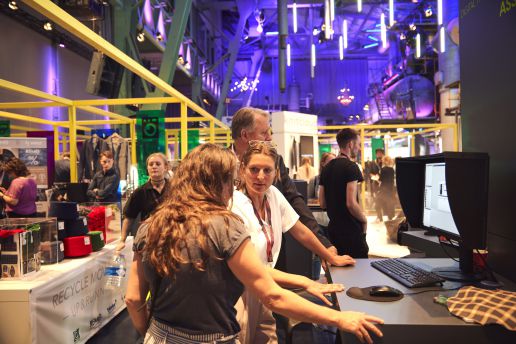

Assyst GmbH
Europaallee 10
67657 Kaiserslautern
Germany
/ STAGE 5 /
# REAL TIME QUALITY ASSURANCE
Based on the speed, transparency and accuracy of Triple Tree Solutions, premium quality management and assurance
solutions is ensured in every stage of textile and apparel manufacturing and sourcing. Using the intuitive and modern user interface, our online quality management system QUONDA visualise all measurements and evaluations throughout the chain. The results are available in real-time and accessible by all members involved, across all devices.
Here at KEYHOUSE we demonstrate the process of colour evaluation, as well as provide a summary and evaluation of the results of the four simulation stations. Digital colour matching between the manufacturer and customer significantly accelerates the procurement process, saves costs and also lowers the carbon footprint of the participating companies by avoiding unnecessary transport – Green Sourcing!

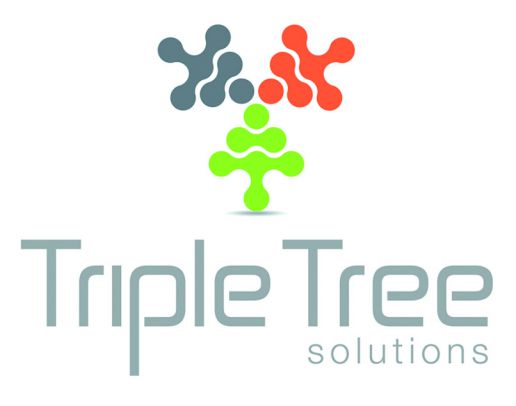
Triple Tree
Kaiserswerther Straße 115
40880 Düsseldorf-Ratingen
Germany
KPMG x Microsoft: Merging Business, Technology and Fashion
Every industry is experiencing massive changes thanks to advancements in technology that are leading the way with new applications, services and opportunities. Revolutionising how companies manage, manufacture, market and sell, new technology is transforming customer expectations by changing how people communicate, live and shop.
Nowadays, for a company to thrive, it has to decide its level of technological integration. Easily described as a service, technology is already impacting various industries in different ways. According to KPMG, one of the leading auditing and consulting companies in Germany, one of those industries is fashion, particularly retail, where we are witnessing a radical shift in established brands that are not only being challenged by digital-enabled newcomers but also by customers who are smart, mobile-empowered, socially networked, and able to influence a brand’s reputation.

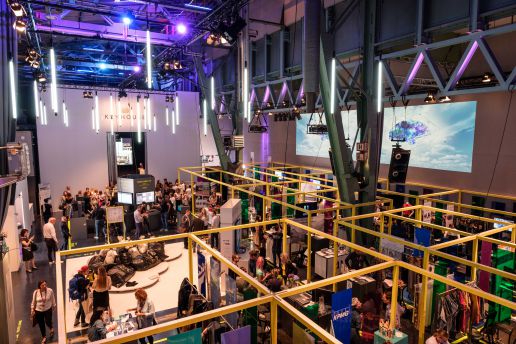
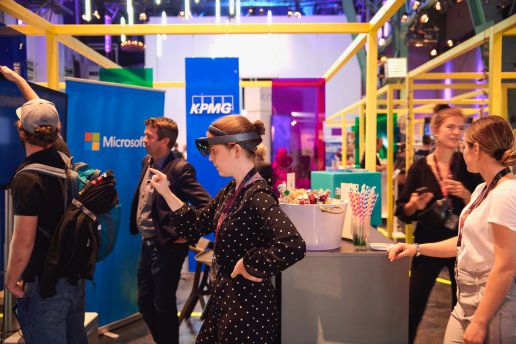
Ushering in a New World of Retail Fashion
Bringing business, technology and fashion to Munich Fabric Start’s Keyhouse this season, KPMG and IT-lighthouse Microsoft have come together to disrupt the future of fashion. It is a partnership that is presenting business and technology expertise to those within the fashion industry. KPMG wants to make a massive change in fashion by introducing disruptive technology that will transform many things like the means of communication by creating processes to collaborate and explore.
Working together with Microsoft, KPMG has found a new way to satisfy customers through their Omni Channel solution, which enables companies to gain a full 360° view of all customer touch points. They are also looking to empower employees with actionable processes that will fulfil the customer success story. Their end goal is to offer a new way that will successfully satisfy the modern customer by introducing a combination of HoloLens, a new POS system, better process management tools and social media engagement designed to usher in a new world of retail fashion.
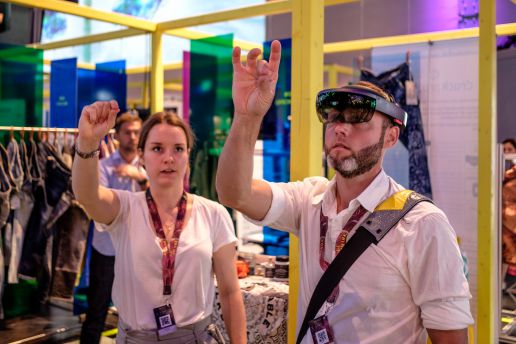
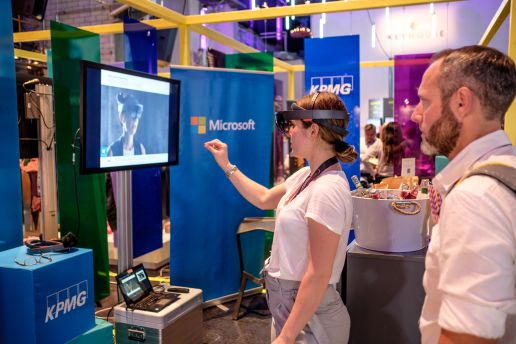
Besides the partnership presenting an in-depth business and technology expertise to the fashion industry, KPMG has also taken a multifaceted approach so they can offer innovative solutions regarding customer acquisition, loyalty and reward programs, integrated marketing and social media strategies while enabling transparency throughout production and supply chain delivery. This is because KPMG has found all these topics to be of importance to the modern customer and therefore, likely to affect the bottom line of a fashion business.
Together both companies presented the Omni Channel strategy at the Keyhouse, our visitors experienced how the HoloLens, with integrated digital transformation, can help fashion businesses gain increased brand visibility. KPMG also shared their know-how on how companies can get the first-to-market advantage using HoloLens.
